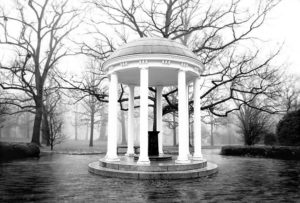The names of developments in and around Chapel Hill are more discouraging than the places themselves could ever be. In Plantation Acres, the plantation is long gone. In Timberlyne, the timber was harvested long ago. In Meadowmont there is no meadow left. Other developments evoke a past that never existed. No chancellor ever lived in Chancellor’s Ridge. No village predated Southern Village. Maida Vale, just over the Durham line, looks nothing like that district in London – its outsized homes are Spanish colonial. Developers seem to expect homebuyers to be nostalgic, but ignorant.
Where did this trick of nomenclature come from? A short article cannot attempt to fathom the depths (and shallows) of real estate psychology. But we may discover the origin of this trick. Chapel Hill’s original developer, the university, has been playing it for centuries.
Take the Old Well. Every town resident knows this landmark, a symbol of the qualities that gave Chapel Hill its sobriquet, the Southern part of Heaven. Turns out, the Old Well is neither unique, nor old, nor, for that matter, even a well. The name is trebly misleading.
In UNC’s early years, there were wells all over the place. Neither the college nor the adjacent town had a water system, so every building or group of buildings used a well. One well served a tavern on the land where Graham Memorial Hall now stands. That well predated the one the trustees put in front of South Hall in 1795. Another well, in front of the Poor House, where Vance and Pettigrew halls now stand, got filled in during the 1830s and 40s, when the Poor House got demolished (but the poor only dispersed). Another well served New East, a building erected in 1860; in 1897 the weekly Tarheel observed that it needed cleaning, a frequently required service costing a dollar and a quarter.
Wells got filthy because the campus and the town were filthy. For decades, the only urinals were tin pots nailed below dorm windows. Campus pigs dined on university garbage. Chamber pots and refuse removal were both improvements, but there were no flush toilets or showers until 1894, when an enterprising chemistry professor installed them, along with running water for his laboratory, in the basement of what is now Playmakers Theater.
Around this time the town and the college began installing a water system, but the wells stayed in use. Owners put sheds around them, and then the expanding college plunked for decorative sheds. The biggest well, on Cameron Avenue in front of Old Memorial Hall, had the honor of being housed in a two-story wooden pagoda.
In the fall of 1897, President Alderman, after years of looking out his first-floor window in South Hall and grimacing at the buckets and chains of the well across the way, decided to go the pagoda one better, and house his well in an open-air Roman temple, modeled on the temple of love near the Petit Trianon in Versailles. The future “old well” became a fancy well—but not very fancy, since it still had buckets and chains. It wasn’t in quite the right place, either – about a foot and a half short of lining up properly with the front door of South Hall. It was just another well, with no shrubbery or walkways. For a time, it stood in some danger of being plugged; the university planned to build a belfry there, at the center of the original campus. But as it happened, the university lacked funds for a belfry, just as it had lacked funds for chamber pots, and later for water pipes.
After UNC got bigger and richer, it built a belfry at the center of what had become a much larger campus—the bell tower that now rises behind Wilson Library, and dominates the skyline as far south as the Medical and Dental Schools. The college’s wells progressed, too. Down came the pagoda, and down came Old Memorial Hall. The well in front of South got a pump. In 1925 it got a water fountain, and after it was rebuilt in 1954, without any great change to its shape or size, it drew water from the city pipes instead of from the ground. It also got moved opposite the front door, which, at the turn of the new century, had received a colonial pediment.
Once one well among many, and then a fancy well, and then a water fountain, the un-well became a symbol. The university promoted the notion of students drinking from the Old Well for good luck. When TV crews came to the campus, they parked beside it for a photo-op.
All the real wells were obliterated and forgotten. The university didn’t want anything so primitive as a bucket or a pump, any more than it wanted a tavern opposite a poorhouse. So when we go to the Old Well to drink, we drink in nostalgia.
The university never was a temple of love or learning, any more than Chapel Hill was a romantic, perfect little town. There was just a livable, imperfect town, a little out of alignment, like the well in front of South Hall. Chapel Hill was smaller then, as Daniel Webster once said of Dartmouth: “A small college, your Honor, but there are those who love it.”
Fred Naiden teaches ancient history at UNC and lives in Chapel Hill.

